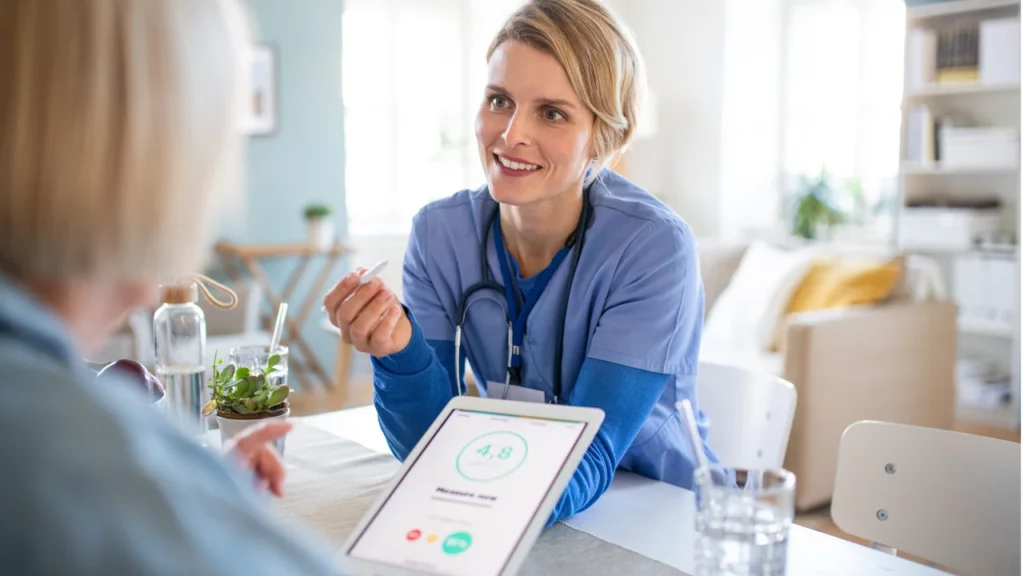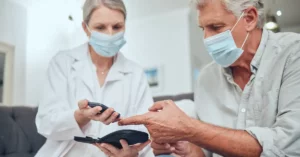The integration of Remote Patient Monitoring (RPM) into healthcare is revolutionizing patient care, moving us towards a future where technology empowers both providers and patients. In this article, we explore how this synergy is reshaping healthcare, making it more connected, efficient, and patient-focused. Let’s delve into the transformative impact of RPM and the new standards it’s setting in the healthcare landscape.
The Rise of RPM in Healthcare
The journey of RPM from a novel concept to a cornerstone of modern healthcare illustrates a significant shift towards embracing technology to enhance patient care. Initially conceptualized to monitor patients remotely and reduce the frequency of in-person visits, RPM technology has rapidly evolved, finding its place at the heart of healthcare innovation. Today, RPM is not just about monitoring; it’s a comprehensive approach that integrates with broader healthcare solutions to offer unprecedented levels of care and management for chronic conditions such as hypertension.
Through the integration of RPM into healthcare systems, patients receive a more holistic care experience. Real-time data collection and analysis facilitate timely interventions, personalized care plans, and improved communication between patients and healthcare providers. This evolution signifies a transformative period in healthcare, where RPM’s integration into comprehensive healthcare solutions is not just an option but a necessity for advancing patient care and health management.
Integrating RPM into Healthcare Solutions
The integration of RPM into broader healthcare solutions represents a critical step forward in achieving a more holistic approach to patient care. This seamless fusion allows for continuous monitoring of patients’ health data, bridging the gap between traditional in-clinic visits and modern, digital healthcare management. Key to this integration is the compatibility of RPM technologies with existing healthcare systems, enabling real-time data flow and analysis. This not only enhances the accuracy of patient health assessments but also facilitates timely interventions by healthcare providers.
By incorporating RPM into integrated healthcare solutions, patients benefit from a more cohesive care experience. Healthcare professionals can now access a comprehensive view of a patient’s health status, leading to more informed decision-making and personalized care plans. Moreover, this integration supports proactive health management, allowing conditions like hypertension to be monitored and managed with unprecedented precision and effectiveness.
The success stories of RPM integration highlight significant benefits, including improved patient outcomes, reduced hospital readmissions, and greater patient satisfaction. Through the lens of integrated healthcare solutions, RPM emerges not just as a tool for monitoring but as a fundamental component of a transformative healthcare paradigm.
Challenges and Solutions in Integration
The path to fully integrating RPM into healthcare solutions is not without its obstacles. These challenges range from technical hurdles, such as ensuring device compatibility and data accuracy, to systemic issues like interoperability and healthcare provider adoption. Despite these barriers, innovative solutions and strategic approaches are paving the way for successful integration.
| Challenge | Solution |
|---|---|
| Technical Hurdles | Implement validation and standardization for RPM devices. Use advanced encryption and secure transmission for data privacy and security. |
| Interoperability Issues | Adopt universal data standards and protocols to facilitate seamless data exchange between RPM systems and healthcare infrastructures. |
| Healthcare Provider Adoption | Highlight the benefits of RPM, such as improved patient outcomes. Offer training and support to ease the integration process for providers |
The Impact of Integrated RPM on Patient Care
The integration of RPM into healthcare solutions has a profound impact on patient care, marking a significant shift towards more personalized and proactive health management. This comprehensive approach not only streamlines the monitoring process but also empowers patients to take an active role in their own health care.
Enhanced Patient Outcomes
The real-time data provided by RPM allows healthcare providers to make more informed decisions, leading to better management of chronic conditions like hypertension. This has been shown to reduce the number of emergency room visits, lower hospital readmission rates, and improve overall health outcomes.
Increased Patient Engagement
With RPM, patients are more engaged in their health care journey, thanks to the continuous feedback and education they receive. This engagement fosters a deeper understanding of their health condition and encourages adherence to treatment plans.
Greater Accessibility to Care
RPM breaks down geographical barriers to healthcare access, making it easier for patients in remote or underserved areas to receive the care they need. This increased accessibility ensures that more individuals can benefit from continuous health monitoring without the need for frequent travel to healthcare facilities.
The integration of RPM into healthcare solutions represents a pivotal advancement in the way care is delivered, emphasizing the importance of technology in shaping the future of healthcare. By harnessing the power of RPM, healthcare providers can offer a level of care that is not only more efficient but also more attuned to the needs and preferences of patients, paving the way for a healthier society.
The Role of Technology and Innovation
The seamless integration of RPM into healthcare is propelled by continuous technological innovation and the development of advanced digital tools. This evolution is crucial for enhancing the functionality, accessibility, and effectiveness of RPM solutions, ultimately driving better health outcomes for patients with conditions like hypertension.
Advancements in RPM Technologies
Cutting-edge developments in sensor technology, data analytics, and artificial intelligence are making RPM devices more accurate, user-friendly, and capable of providing deeper insights into patient health. These innovations enable personalized care plans that adapt in real-time to the patient’s health status, improving the management of chronic conditions.
Improving Accessibility and Usability
Technology companies are focused on creating RPM solutions that are not only effective but also accessible to a broader range of patients, including those with limited technological proficiency. Innovations in user interface design and device interoperability are key to achieving this goal, ensuring that patients of all ages and backgrounds can benefit from RPM.
Future Directions
The future of RPM lies in the further integration of AI and machine learning algorithms, which can predict health trends and prevent adverse health events before they occur. Additionally, the expansion of telehealth services complements RPM by providing patients with real-time access to healthcare professionals, further enhancing the care experience.
Innovation in technology is the cornerstone of advancing RPM, offering new opportunities to revolutionize healthcare delivery. As these technologies continue to evolve, the potential of RPM to support integrated healthcare solutions becomes increasingly significant, setting the stage for a future where technology-driven care is the norm.
Policy and Regulatory Considerations for RPM Integration
The widespread adoption and integration of RPM into healthcare systems are significantly influenced by policy and regulatory frameworks. These considerations play a pivotal role in shaping the landscape of RPM, from device approval to patient privacy, and reimbursement models.
Navigating Regulatory Landscapes
- RPM technologies require approvals from regulatory bodies like the FDA.
- Clear guidelines are essential for compliance and fostering trust.
Supporting Reimbursement Models
- Sustainability depends on supportive reimbursement policies.
- Recognizing RPM’s value can encourage wider adoption among healthcare providers.
Protecting Patient Privacy
- Essential policies must safeguard the privacy and security of health data.
- Compliance with laws like HIPAA is crucial for protecting patient information.
Enhancing Care with DrKumo’s RPM Solutions
DrKumo RPM solutions are transforming the management of chronic conditions like hypertension by integrating seamlessly with healthcare systems, enabling real-time monitoring and patient empowerment at home. This approach not only provides healthcare professionals with timely data for intervention but also improves patient access to care, regardless of their geographical location.
By embodying the positive impacts of RPM on patient care, DrKumo demonstrates how technology can elevate healthcare delivery and outcomes, positioning itself as a leader in the movement towards more personalized and efficient patient care in the digital era.
Frequently Asked Questions
Can RPM devices be used by patients with limited technical skills?
Yes, RPM devices are designed with user-friendliness in mind, ensuring that patients of all ages and technical abilities can easily use them. Training and support are also provided to help users become comfortable with the technology.
Are RPM data and insights accessible in real-time to healthcare providers?
Absolutely. RPM platforms transmit health data in real-time, allowing healthcare providers to monitor patients’ conditions continuously and intervene promptly when necessary.
How does RPM cater to patients in remote or underserved areas?
RPM eliminates geographical barriers to healthcare by enabling patients in remote or underserved areas to receive high-quality care and continuous monitoring without the need for frequent travel to healthcare facilities.
What measures are in place to ensure the privacy and security of health data collected through RPM?
RPM systems adhere to strict privacy and security standards, including encryption and secure data transmission protocols, to protect patient information in compliance with laws like HIPAA.
Can RPM be integrated with existing Electronic Health Records (EHR) systems?
Yes, many RPM solutions are designed to be interoperable with existing EHR systems, facilitating seamless communication and data exchange between RPM devices and healthcare providers’ records systems.
Takeaways
The integration of Remote Patient Monitoring into healthcare is reshaping patient care, emphasizing the need for innovation, supportive policies, and collaboration. As RPM continues to evolve, embracing it as a cornerstone of modern healthcare is crucial for enhancing outcomes and ensuring equitable access to services. This revolution in healthcare, led by RPM, promises a future where technology-driven care is the norm, benefitting patients worldwide.
Unlock the potential of integrated healthcare solutions with DrKumo’s RPM technology. Contact DrKumo today to revolutionize patient care in your practice.









